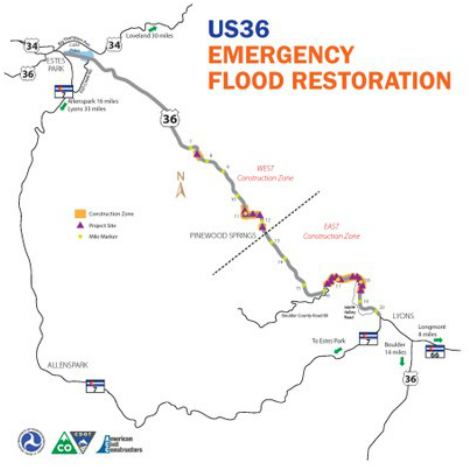Highway Reconstruction - Flood Repairs
In September, 2013, a slow-moving cold front stalled over Colorado, clashing with warm humid air from the south, resulting in a severe rain event that lasted a week and caused catastrophic flooding and damage along Colorado’s Front Range. Colorado Governor John Hickenlooper declared a disaster emergency on September 12th. Two days later, a Major Disaster Declaration was issued (DR-4145) by President Obama for federal aid to supplement state and local recovery efforts in the area affected by severe storms, flooding, landslides and mudslides. Initially the presidential declaration included 14 counties, but four counties gained funding from the original declaration due to CDOT’s rapid response and compilation of detailed damage assessment reports that demonstrated the need for additional assistance.
The disaster impact area extended over 200 miles from north to south and includes communities from Pueblo to Fort collins.
More than $535 million estimated in state highway and local roadway damage
Emergency (Temporary) Repairs Sept. 12, 2013 to Spring 2014
Thirty-nine major interstate and highway roadway segments, along with numerous local agency roads, were temporarily closed due to the flood event. In an effort to get residents back into their homes and re-establish access to isolated communities as quickly as possible, Gov. Hickenlooper directed CDOT to re-open all impacted interstates and highways by Dec. 1, 2013. This required an enormous undertaking and cooperative effort between CDOT, FEMA, the Federal Highway Administration (FHWA), the National Guard, local agencies, 39 contractors and three major consultant teams. To achieve Gov. Hickenlooper’s directive, CDOT focused on implementing fast-track, temporary repairs to provide sufficient infrastructure to support basic mobility requirements. Temporary repairs included debris removal and rock scaling, roadway repairs, construction of bypass roadways, and stabilization of bridge structures. Through this intensive temporary repair effort, all impacted CDOT roadways were re-opened before the Dec. 1st deadline. Additional emergency repairs continued to be made through the spring of 2014.
Permanent (Long-Term) Repairs Spring 2014 to December 2018
The repairs implemented during the emergency response phase of recovery were short- term fixes to get traffic moving as quickly as possible. However, many of these repairs are not adequate for the long-term needs of the transportation system. Therefore, CDOT has established an aggressive, long-range plan to systematically develop and construct permanent repairs for affected infrastructure. Work under this plan is anticipated to occur over a span of approximately five years and will range from small debris removal projects to major corridor repair and reconstruction projects. These repairs began in Spring 2014 with US 36 from Lyons to Estes Park as the first project to move forward. The plan addresses only those roadways that are owned and maintained by the State. Long-term repairs to local roadways will be implemented by local agencies. Use the CDOT interactive map to view planned projects.
Highway 34 Updates - CDOT Link
Highway 36 Updates - CDOT Link
The disaster impact area extended over 200 miles from north to south and includes communities from Pueblo to Fort collins.
More than $535 million estimated in state highway and local roadway damage
Emergency (Temporary) Repairs Sept. 12, 2013 to Spring 2014
Thirty-nine major interstate and highway roadway segments, along with numerous local agency roads, were temporarily closed due to the flood event. In an effort to get residents back into their homes and re-establish access to isolated communities as quickly as possible, Gov. Hickenlooper directed CDOT to re-open all impacted interstates and highways by Dec. 1, 2013. This required an enormous undertaking and cooperative effort between CDOT, FEMA, the Federal Highway Administration (FHWA), the National Guard, local agencies, 39 contractors and three major consultant teams. To achieve Gov. Hickenlooper’s directive, CDOT focused on implementing fast-track, temporary repairs to provide sufficient infrastructure to support basic mobility requirements. Temporary repairs included debris removal and rock scaling, roadway repairs, construction of bypass roadways, and stabilization of bridge structures. Through this intensive temporary repair effort, all impacted CDOT roadways were re-opened before the Dec. 1st deadline. Additional emergency repairs continued to be made through the spring of 2014.
Permanent (Long-Term) Repairs Spring 2014 to December 2018
The repairs implemented during the emergency response phase of recovery were short- term fixes to get traffic moving as quickly as possible. However, many of these repairs are not adequate for the long-term needs of the transportation system. Therefore, CDOT has established an aggressive, long-range plan to systematically develop and construct permanent repairs for affected infrastructure. Work under this plan is anticipated to occur over a span of approximately five years and will range from small debris removal projects to major corridor repair and reconstruction projects. These repairs began in Spring 2014 with US 36 from Lyons to Estes Park as the first project to move forward. The plan addresses only those roadways that are owned and maintained by the State. Long-term repairs to local roadways will be implemented by local agencies. Use the CDOT interactive map to view planned projects.
Highway 34 Updates - CDOT Link
Highway 36 Updates - CDOT Link
Video: Johnny Olson, CDOT Regional Transportation Director gives highway flood repair update to residents at the August 2014 Road to Recovery Expo in Estes Park.
| US 36 CDOT Permanent Repairs.pdf | |
| File Size: | 9680 kb |
| File Type: | |
| CDOT Flood Expo Presentation.pdf | |
| File Size: | 11520 kb |
| File Type: | |
Photo Courtesy, Shahn Sederberg - CDOT


